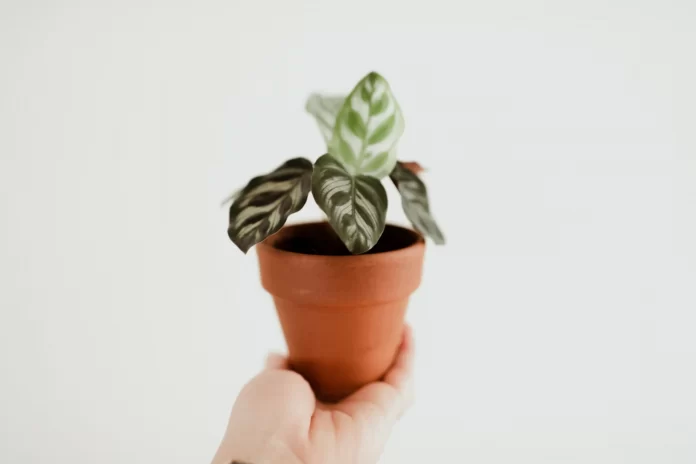Calathea can be justifiably considered the emerald of any floral collection – both by famous florists and by ordinary commoners. However, before you grow this tropical flower in your home, you should clearly understand that you will have to care for it sensitively and for a long time.
Nevertheless, none of the care requirements is impossible. Otherwise, we would be able to see Calathea only in places of its historical growth (in the tropics and subtropics), or in real baroque chambers with maintaining the necessary climate artificially. Of course, this is far from being the case.
Here is how to grow Calathea “White Fusion” in your home.
What to know about the Calathea
Calathea is a plant of the second level of the rainforest and belongs to the Marantaceae family. The leaves of Calathea are oval and elliptical up to 30 cm long. They can be velvety and glossy, with the back always having shades of red in the color. You can admire the complex pattern of the leaf plate endlessly. Leaves grow on a trunk, but it is short, the internodes are millimeters apart, the rosette seems to grow out of the ground. The length of the leaf petioles varies.
The name of this flower comes from the Greek word “calathos”, which literally translates as “basket”. The fact is that in ancient times, Calathea leaves were used to weave baskets.
Improper care for Calathea at home will kill the plant. The reaction to improper care will be a change in the color of the leaves, their drooping, the appearance of various spots, and the drying of the edges. This is also called loss of ornamental value.
It is believed that the first Calatheas grew in the tropical rainforests of South America, occupying the first and second tier of forests. This is why the plant likes lots of diffused rather than direct light. Later Calathea successfully spread to Central America, where it is still found in the wild today.
How to care for Calathea after purchase from the flower shop
Remember that the biggest and most common problem from which Calatheas die is dry air in the apartment. In second place is the lack of light or direct sunlight on the flower. Of course, before buying, you need to find a place where there will be the most light during the day. However, protect the flower from direct sun with screens or other improvised objects.
You can humidify the air by frequent spraying of water near the plant, as well as by placing saucers of water for natural evaporation of liquid. Now that the space is ready, you can buy your first Calathea in a store.
Remember that quarantine is mandatory for this plant. You need to keep it for 1-2 weeks without taking any action on transplanting, fertilizing, etc. Even watering the Calathea isn’t recommended immediately, but three days after purchase, when the plant is more or less adapted to the new place. During this quarantine time, it will become clear whether the flower was grown correctly in the store. All possible fungi, infections, diseases, and pests in the new conditions will immediately make themselves known.
Light
The total daylight hours for Calathea regardless of the location is 15-16 hours. It can be a shaded place near a southern window or extra light when placed on the north side. It is necessary to be guided by the coloring of the leaves. If there is a lack of light, the leaves are pale, if there is too much, they become shallow and curl up into a tube. If no action is taken, the leaves will wither and fall off after turning pale.
Soil selection
The selection of soil is one of the requirements of how to properly care for Сalathea. Given that the roots of the plant are shallow and grow wide, it is necessary to select an appropriate pot. A deep bucket creates a larger drainage layer so that the soil below doesn’t sour.
Mixtures recommended for African violets are often good for Calathea varieties such as “White Fusion” because they retain moisture well and drain excess water. You can make a peaty, airy, light potting mix by mixing orchard bark, perlite, and standard potting soil.
What kind of pot does Calathea need
Any kind of pot that can be found on the market will do. When choosing between a clay pot and a plastic pot, choose the latter. Clay pots absorb moisture, which increases the risk of stagnant liquid in the pot and thus rotting the roots.
Temperature and air humidity
Obviously, Calathea prefers warmth, because it comes from the tropical zone. This means that it needs at least +20°C in summer and between +15-18°C in winter.
Growing a Calathea, you will have to keep a very close eye on the humidity in the room. You need to keep it at 90% or higher.
Firstly, you will have to introduce the practice of constant sprinkling of water from a sprayer – up to 3-4 times a day. This is typical both for the summer and winter when the air is strongly dried by working heating batteries. When sprinkling water, try to get as little as possible on the flower, its leaves, and flowers. Point the sprinkler sideways.
Secondly, it is advisable to leave a saucer or any other container of water next to the flower. The humidity will be higher from the natural evaporation of the liquid.
Water
All varieties of Calathea are watered only with soft, evaporated water at a temperature of 2-3 degrees above room temperature. Watering should be guided by the condition of the plant. If the leaves begin to lose their turgor, stop moistening, dry the soil 2-3 cm deep into the soil and wait for results. If the leaves don’t come up, care of the Calathea requires replacing the soil and removing the rotten roots.
The frequency of watering is as the clump dries out and the type of leaves. In hot weather 3 times a week, in winter only once a week.
Fertilization and pruning
Your Calathea “White Fusion” will appreciate a monthly liquid fertilizer supplement during the growing season, spring through fall. Stop fertilizing in the winter. Choose a fertilizer designed for densely foliaged houseplants, most likely richer in nitrogen. The plant will only need a weak dose or half the dose recommended on the fertilizer container.
If your Calathea “White Fusion” has several leaves that have turned brown or are excessively curled, don’t be afraid to cut them off at the stem. Cut back any dead, dying, or damaged leaves as soon as you notice them and remove them from the soil. If your plant is healthy and given the right care and conditions, new leaves will grow and replace the dead ones. Remove wilted flowers.
To begin with, you can grow a beautiful Calathea in a Wardian case, a tall vessel with transparent panels. This way, it is easier to maintain a microclimate.






